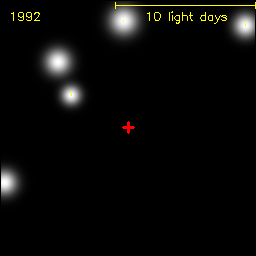Tom Hartman's Physics Homepage

me
I work on quantum gravity and quantum field theory, with a focus on black hole information and strongly coupled quantum fields.

Black hole video
This is a video (not a simulation!) of stars orbiting the supermassive black hole at the center of the Milky Way, over a 14-year period.
Source: R. Narayan.
Research
- My physics papers on Spires / Arxiv / Google scholar
Software
Teaching
- Black holes and Quantum Information - Fall 2021
- Advanced General Relativity -- Spring 2017
- Quantum Gravity and Black Holes -- Spring 2015
- Lecture notes on some advanced topics
Research Overview
String theory aims to unify the four forces and to provide a consistent framework for quantum gravity. Despite many theoretical successes, it has yet to make contact with experiment, or to answer some of the key questions that a theory of quantum gravity must address: What is dark energy? How do we describe the very early universe, where ordinary notions of space and time break down? What degrees of freedom make up black holes, and how do they evolve? Are there consistent alternatives to string theory?
To answer these questions, or to make robust, testable experimental predictions, it is likely that fundamentally new ideas are required. A promising candidate for such an idea is holography, an approach to quantum gravity based on the observation that the laws of gravitation can be recast as the laws of thermodynamics. This suggests that gravity is an emergent, statistical phenomenon. The most detailed incarnation of holography is the AdS/CFT correspondence, which equates a theory of quantum gravity in d + 1 dimensions to a field theory on the d-dimensional boundary. Though many details of the correspondence are understood, how the underlying degrees of freedom reorganize themselves into an emergent spacetime remains a mystery.
One goal of my research is to use holography to understand quantum gravity, and ultimately, to use holography to make experimental predictions for physics below the Planck scale. Another goal is to use gravity to gain insight into quantum field theory. Some specific topics include:
- AdS/CFT and its generalizations, with and without string theory;
- Black hole phenomena, thermodynamics, and quantum information;
- Classical and quantum gravity in lower dimensions, and other solvable sectors and toy models of string theory;
- Applications of holography to experimentally accessible physics, including condensed matter systems and astrophysical black holes;
- New approaches to the early universe, inflation, and the physics of de Sitter space.